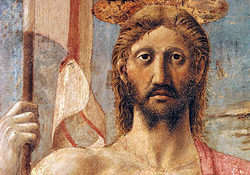 All Catholics are familiar with the Via Crucis (Way of the Cross), the best known devotion on Fridays in Lent following the Lord to His death on the cross. It must be said it's a very appropriate devotion each Friday through the year. On Good Friday there's usually a mega-observance of the Way of the Cross in parish churches, in the Roman Coliseum with the Pope or in New York City sponsored by Communion & Liberation.
All Catholics are familiar with the Via Crucis (Way of the Cross), the best known devotion on Fridays in Lent following the Lord to His death on the cross. It must be said it's a very appropriate devotion each Friday through the year. On Good Friday there's usually a mega-observance of the Way of the Cross in parish churches, in the Roman Coliseum with the Pope or in New York City sponsored by Communion & Liberation.
As we know Pope John Paul II was big on the Via Crucis as a daily spiritual exercise; other spiritual giants did the same and I think we all would benefit from keeping the Cross in front us by praying the Via Crucis. What is little known is that John Paul also advocated a devotion called the Via Lucis (Way of Light): The Stations of the Resurrection. The Via Lucis is an apt way to recall the saving events of the Paschal Triduum. While there are no physical objects called "Stations of the Resurrection" to follow in our churches (at least not yet) there is no reason why we can't create them. Let me say from the outset, the Via Lucis is not merely a nice thing to do in the Easter season but an essential practice for getting to know the Lord better so as to live the Christian faith more intensely because we are the witnesses to the world of the fact of the Resurrection of Jesus.
The Directory of Popular Piety and the Liturgy (2001) says:
A pious exercise called the Via Lucis has developed and spread to many regions in recent years. Following the model of the Via Crucis, the faithful process while meditating on the various appearances of Jesus - from his Resurrection to his Ascension - in which he showed his glory to the disciples who awaited the coming of the Holy Spirit (cf. John 14, 26; 16, 13-15; Lk 24, 49), strengthened their faith, brought to completion his teaching on the Kingdom and more closely defined the sacramental and hierarchical structure of the Church.
Through the Via Lucis, the faithful recall the central event of the faith - the resurrection of Christ - and their discipleship in virtue of Baptism, the paschal sacrament by which they have passed from the darkness of sin to the bright radiance of the light of grace (cf. Col 1, 13; Ef 5, 8).
For centuries the Via Crucis involved the faithful in the first moment of the Easter event, namely the Passion, and helped to fixed its most important aspects in their consciousness. Analogously, the Via Lucis, when celebrated in fidelity to the Gospel text, can effectively convey a living understanding to the faithful of the second moment of the Pascal event, namely the Lord's Resurrection.
The Via Lucis is potentially an excellent pedagogy of the faith, since "per crucem ad lucem". Using the metaphor of a journey, the Via Lucis moves from the experience of suffering, which in God's plan is part of life, to the hope of arriving at man's true end: liberation, joy and peace which are essentially paschal values.
The Via Lucis is a potential stimulus for the restoration of a "culture of life" which is open to the hope and certitude offered by faith, in a society often characterized by a "culture of death", despair and nihilism. (153)
The Via Lucis
 1. Jesus Rises From the Dead (Matthew 28:1-7)
1. Jesus Rises From the Dead (Matthew 28:1-7)
2. The Disciples Find the Tomb Empty (John 20:1-9)
3. The Risen Lord Appears to Mary Magdalene (John 20:11-18)
4. The Risen Lord Appears to Two Disciples on the Road to Emmaus (Luke 24:13-27)
5. The Risen Lord Is Recognized at the Breaking of Bread (Luke 24:28-35)
6. The Risen Lord Appears to His Disciples (Luke 24:36-43)
7. The Lord Gives the Power to Forgive Sins (John 20:19-23)
8. The Lord Confirms the Faith of Thomas (John 20:24-29)
9. The Risen Lord Meets His Disciples on the Shore of Lake Tiberias (John 21:1-13)
10. The Risen Lord Confers the Primacy on Peter (John 21:15-17)
11. The Risen Lord Entrusts to His Disciples the Mission to the World (Matthew 28:16-20)
12. The Risen Lord Ascends to the Father (Acts 1:6-11)
13. Waiting for the Holy Spirit With Mary, the Mother of Jesus (Acts 1:12-14)
14. The Risen Lord Sends the Holy Spirit Promised to the Disciples (Acts 2:1-13)


Leave a comment